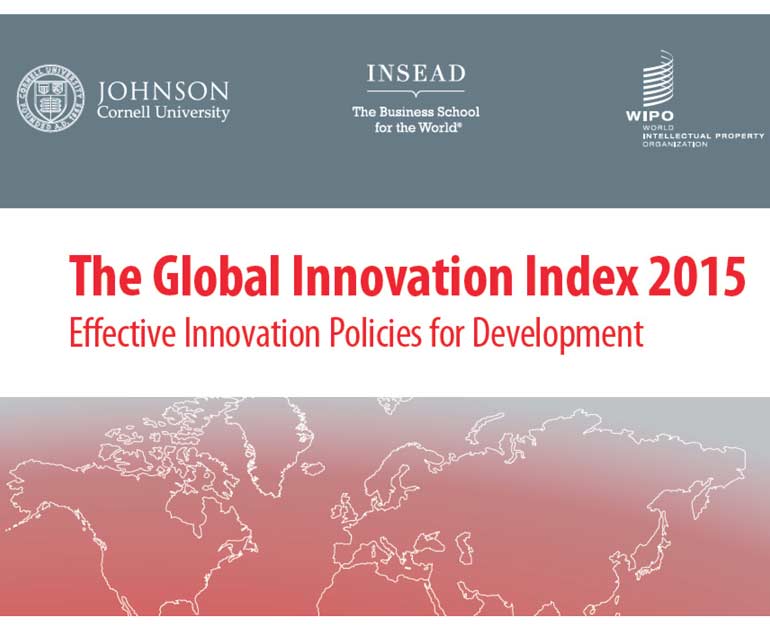Wednesday Jul 02, 2025
Wednesday Jul 02, 2025
Monday, 28 September 2015 00:00 - - {{hitsCtrl.values.hits}}

Need for modelling growth on knowledge
As pointed out in the previous two parts, Social Market Economy to be set up in Sri Lanka has been qualified by two attributes by its proponents. It is to be ‘knowledge-based’ and it is to be ‘competitive’.
‘Knowledge-based’ means that the economy will be dependent on ‘the quantity, quality and accessibility of information available instead of traditional means of production’ that are normally used for economic activities.
Sri Lanka being a relatively resource-poor country has to model its future economic growth on its knowledge base which has to be accumulated through education, training and research and development. Competition will create an enabling environment for productive use of that knowledge base across the economy by offering fair opportunities for everyone to engage in economic activities.
Knowledge should be relevant as well as applicable
Creation of knowledge is one thing but using that knowledge for economic activities is another. London University’s Education Professor Alison Wolf in her 2002 book ‘Does Education Matter? Myths about Education and Economic Growth’ says that education or knowledge matters if there is relevant knowledge and if there is an enabling environment for using that knowledge productively.
This was elaborated in economic terms by Austrian-American economist Joseph Schumpeter in his 1911 book ‘The Theory of Economic Development’ and in his subsequent publications. According to Schumpeter, continuous economic growth comes from innovation which is different from invention, the creation of an output of knowledge.
Inventions do not help unless they are used commercially
Knowledge will enable researchers, engineers and scientists to create new things which are known as inventions. There are thousands of such inventions made by knowledgeable people every day but not all these inventions lead to creating a commercially viable new product or service.
For instance, there are stories of some Sri Lankan youth inventing remarkable new products such as a sea-water driven motor car or a multi-tasked paddy-thresher. While such inventions have their own merit, they may not be commercially viable at the current stage of technology due to a higher cost of production than available alternatives.
Hence, they just remain as prototype inventions incapable of going through an assembly line of a factory that depends on commercial viability for its survival. Schumpeter says that these inventions are used by entrepreneurs by converting them into commercial production lines. That process is called innovation.
Researchers lack capacity to use inventions commercially
According to Schumpeter, innovation leading to the continuous economic growth of a country is a process and it consists of four stages. The first stage is the invention where a researcher or a scientist, through elaborate experiments, comes up with a prototype of a new product.
At the time of creating these inventions, the scientist or the researcher concerned has no idea about whether they will be commercially viable. He only knows that it will change the prevailing world habits or systems.
Commercial viability comes from two other factors. One is that there should be a demand for the new product in preference to what is presently available in the market. The other is that the producers should be able to produce it at a cost that would generate a profit when sold at prevailing market prices. If these two conditions are not met, the prototype invention will just remain an invention only on paper.
It is entrepreneurs that generate innovations
In the second stage known as innovation, enterprising people will draw, according to Schumpeter, on the discoveries of scientists or inventors and convert them into commercially viable products or services.
By doing so, they create new opportunities for investment, growth and employment. But for them to do so there should be mechanisms for making such new discoveries available to them for use in commercial production and a guarantee of their right to use them, known in economics as ‘property rights’.
This involves linking research institutions with business. In the case of private research institutions, the question does not arise since private researchers should necessarily have to sell their research outputs to those who could use them productively.
The problem arises with respect to State-owned universities and research institutions which are normally reluctant to pass their research outputs to private sector-owned businesses. Though such disabilities are not there in the case of State-owned businesses, such businesses do not have proper business acumen to convert a research output into a viable market product.
Steve Jobs innovated the Macintosh desktop invented by Stephan Wozniak
Hence, inventions per se do not lead to economic prosperity. There should be entrepreneurs who are willing and able to convert such inventions into marketable products. A good example is provided by Apple products.
According to the biographer of Steve Jobs, Walter Isaacson, the first Apple Macintosh Desktop was invented by engineer Stephan Wozniak. However, he was not an entrepreneur but a shy engineer. It was the enterprising Steve Jobs who carried the project forward and mobilised the resources needed for producing the Macintosh desktop computer on a commercial basis.
So, if the innovator Steve Jobs were not there, the world would not have had the path-breaking Apple products that revolutionised the world’s information and communication technology applications.

Innovations should get diffused
The third stage is called ‘diffusion’ or making such knowledge available to interested parties through the market mechanism. According to Schumpeter, it is the entrepreneur who performs this task as well.
Diffusion is a concept first put forward by researcher Gabriel Tarde in 1903 when he said that knowledge disseminates over time taking the shape of a slanted English letter ‘S’. This is because every new product has its own ‘product life’ growing rapidly in the initial stage and then coming to a peak before it starts to decline again. At this stage, a new product will take the place of the old discarded product.
Tarde identified five stages of the innovation process: Initial knowledge from the invention done by a researcher, forming an attitude of the invention, deciding whether to adopt or ignore the invention, using the invention in a commercial production and confirming the decision to adopt the invention continuously. Once one innovator comes to the market, there will be others who will follow his lead. It then leads to more inventions and innovations.
Successful innovations are imitated like a pandemic
The final stage arises from diffusion where other entrepreneurs will imitate the initial innovation. At this stage, innovation spreads across the economy like a pandemic. There will be hundreds and thousands of new entrepreneurs who will imitate the initial trailblazers.
This was evident in the computer industry. Before the 1970s, it was the mainframe computers that ruled the world. But after Stephan Wozniak and Steve Jobs broke the rules by producing the first Apple Macintosh desktop, a new desktop computer industry was developed throughout the globe. Then, it was a series of new inventions and innovations that started to supply the world with laptops, tablets, phablets and now hybrid tablets.
Government’s role is to promote innovations
Thus, it is not knowledge per se that will usher prosperity to Sri Lanka. It is the conversion of knowledge into marketable goods and services through innovation, spread of the information on innovation through diffusion and imitation of such innovators that will bring continuous high economic growth to a country.
Hence, the role of the Government is to create an environment conducive for invention, innovation, diffusion and imitation. This is where Sri Lanka lags behind many nations in the world as revealed by the latest Global Innovation Index or GII published by Cornell University, INSEAD and World Intellectual Property Organisation for 2015.
Sri Lanka is a laggard in the global innovation club
Taking into account some 79 different aspects relating to an innovation economy, GII has calculated an innovation score for 141 countries. Of them, Sri Lanka has scored 30.79 marks out of 100, ranking 85th globally.
Historically, Sri Lanka has been a low-level innovation economy and the current GII has confirmed it, though its score and ranking have slightly improved in 2015 compared to 2013. In the latter year, Sri Lanka’s score was 30.4 and its raking was 98. Hence, Sri Lanka’s current position is an eye-opener for the Government which is interested in establishing a ‘knowledge-based competitive social market economy in the country’.
Sri Lanka’s innovation efficiency is low
The index value is the combined outcome of two sub-indices, one on innovation inputs and the other on innovation outputs. The ratio of outputs to inputs depicts the innovative efficiency of a country. If a country has an innovative efficiency ratio of more than or close to one, that country has a high innovative efficiency.
Sri Lanka in this case has an efficiency ratio of 0.76, needing much improvement in the innovation front. The innovation inputs consist of five broad categories, namely, institutional structure, human capital and research, infrastructure, market sophistication and business sophistication.
In innovation outputs, there are two categories, namely, knowledge and technology and creativity. In all these categories, Sri Lanka’s performance as an innovative economy has been far from laudable. It also opens a wide policy corridor for the Sri Lanka Government to adopt for implementation if it is really interested in building its knowledge base and its application in business.
Spend more on research and development
The report has highlighted that it is research and development that lead to technological inventions. A country should secure its technological potential by investing a sufficient amount of resources in R&D. Sri Lanka’s current R&D expenditure stands at 0.2% of its GDP in 2013 in comparison to a world average of 1.7%.
In the case of highly innovative countries like Israel, R&D expenditure has been as high as 4% of GDP. Sri Lanka is currently planning to increase its expenditure on education progressively to 6% of GDP. It is necessary that at least a half of this expenditure be incurred in the R&D area in order to gain the full technological potential that is necessary for Sri Lanka to elevate its status from a lower middle income country to a higher middle income country within the next decade.
The report has also presented six key principles which a country has to follow in order to make it an innovative nation.
Introduce innovations across all industries
Principle 1 requires a country to have an innovation policy aiming at improving innovation in all industries. A country seeking to move from an upper middle income country to a rich country should improve innovations in the manufacturing industry in general and high-tech industry in particular.
However, for a developing country like Sri Lanka where innovations are at a low level, it is necessary at first to improve innovations across the economy.
Don’t allow inefficiency of one sector to rub off onto others
Principle 2 is a further development of Principle 1. It highlights that a country should support through its innovation policy all types and phases of innovation, not necessarily confining itself to high-tech industries. This is because the innovation gains in high-tech industries are negated if other sectors in the economy are lagging behind, causing their inefficiencies to rub off onto improved sectors as well.
Go for disruptive innovations
Principle 3 requires a country to adopt what is known as ‘disruptive innovations’ so that it can directly get itself linked to the advanced economies in the world. This is what Joseph Schumpeter termed as ‘creative destruction’.
The mistake which many countries commit in introducing innovations is to go for marginal improvements in the existing industries.
On the one hand, such marginal improvements are incapable of generating a sufficient prosperity for the nation. On the other, they also widen the technological and innovation gap between the country concerned and other competitors making it difficult to compete with them in global markets.
Make capital goods available at an affordable price
Principle 4 relates to making capital goods imports available, especially those products relating to information and communication technology, at an affordable price keeping such prices low. This is to enable a country to replenish its worn-out capital quickly.
If this is not done, innovation processes started by the country lose steam, productivity improvements stagnate and competitiveness started by businesses starts declining. The way out for countries to do this, according to the report, is to keep tariff and trade barriers low.
Support key innovation inputs as well
Principle 5 highlights the need for supporting the key innovation inputs on a wider scale. In addition to the availability of ‘best-in-class’ ICT, the other inputs such as reliable digital infrastructure, a skilled workforce and new knowledge should also be available to businesses.
It is necessary to support both the production and the transfer of such key innovation inputs to businesses. For instance, if a State-owned research institution comes up with an invention, the Government should have clearly laid out policy principles for private businesses to acquire such inventions having paid the due amounts.
Create a dedicated outfit to implement national innovation strategy
Principle 6 is concerned with developing a national innovation strategy and suitable organisational structures to implement such strategies.
Successful innovation nations have benefited from the creation of such dedicated organisations to carry their national innovation strategies forward.
If such organisations are established under the direct supervision of the head of the state, it would immensely facilitate them to attain their goals easily by coordinating with other State and private organisations.
One innovative businessman is worth more than 100 bureaucrats
Sri Lanka is ranked very low on the global innovators’ scale. If the country is to rescue itself from the depths to which it has fallen, it is necessary for Sri Lanka to produce not only knowledge but also create an environment conducive for it to innovate such knowledge in commercial enterprises.
This is to be done by private entrepreneurs and not by Government bureaucrats. In this context, creating one innovative private businessman is better than producing a hundred Government bureaucrats.
(W.A Wijewardena, a former Deputy Governor of the Central Bank of Sri Lanka, can be reached at [email protected] )
Discover Kapruka, the leading online shopping platform in Sri Lanka, where you can conveniently send Gifts and Flowers to your loved ones for any event including Valentine ’s Day. Explore a wide range of popular Shopping Categories on Kapruka, including Toys, Groceries, Electronics, Birthday Cakes, Fruits, Chocolates, Flower Bouquets, Clothing, Watches, Lingerie, Gift Sets and Jewellery. Also if you’re interested in selling with Kapruka, Partner Central by Kapruka is the best solution to start with. Moreover, through Kapruka Global Shop, you can also enjoy the convenience of purchasing products from renowned platforms like Amazon and eBay and have them delivered to Sri Lanka.
Discover Kapruka, the leading online shopping platform in Sri Lanka, where you can conveniently send Gifts and Flowers to your loved ones for any event including Valentine ’s Day. Explore a wide range of popular Shopping Categories on Kapruka, including Toys, Groceries, Electronics, Birthday Cakes, Fruits, Chocolates, Flower Bouquets, Clothing, Watches, Lingerie, Gift Sets and Jewellery. Also if you’re interested in selling with Kapruka, Partner Central by Kapruka is the best solution to start with. Moreover, through Kapruka Global Shop, you can also enjoy the convenience of purchasing products from renowned platforms like Amazon and eBay and have them delivered to Sri Lanka.